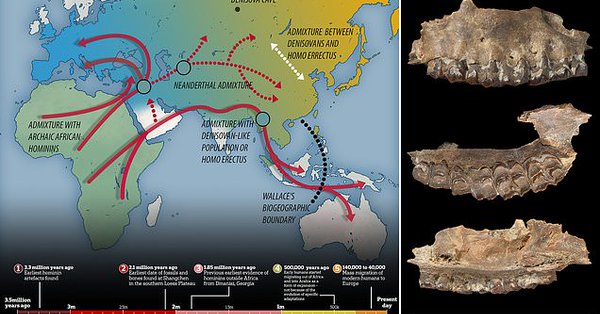The initial expansion out of the continent and into the Arabian peninsula has been found to be a result of a 'range expansion' of early hominids.
Previous research has claimed it was driven by the adaptations of early humans who had evolved to become better suited to the unexplored region.
These latest findings reveal that the hominids were in fact not driven by their adaptations but by a need to expand and occupy new territory.
This was made considerably easier by the abundance of grassland vegetation in the Arabian Peninsula 500,000 years ago.
It also concluded that primitive hominids moved to the new area 100,000 years earlier than previously thought.
A human ancestor dispersed out of Africa in waves via modern-day Egypt and the Middle East before arriving at the Arabian Peninsula.
It is believed that around this time the Homo sapien species (modern-day humans) was distinguishing itself from the more primitive ancestor.
Evidence of this crucial period of time has been difficult to find due to the harsh and barren landscape.
The researchers from the Max Plank Institute for the Science of Human History found stone tools and cut-marks on fossil animal remains at the site of Ti's al Ghadah.
They claim this provides definitive evidence for hominids in Saudi Arabia at least 100,000 years earlier than previously known.
Data from stable isotope data found that that dispersal of our archaic ancestors was down to a range expansion rather than a result of novel adaptations to new environments.
'Ti's al Ghadah is one of the most important palaeontological sites in the Arabian Peninsula and it currently represents the only dated collection of middle Pleistocene fossil animals in this part of the world,' says co-author Mathew Stewart, from the University of New South Wales in Australia.
They studied a 90,000 year old finger bone as well as stone tools that date back to 210,000 years ago.
Herbivore bones that were also found in the region were discovered underneath a lakebed and the scientific dating ranges from 500,000 to 300,000 years ago.
'While these early hominin populations may have possessed significant cultural capacities, their movement into this part of the world would not have required adaptations to harsh and arid deserts,' Dr. Patrick Roberts, the lead author of the paper, explains.
'Indeed, the isotope evidence suggests that this expansion is more characteristic of a range expansion similar to that seen among other mammals moving between Africa, the Levant, and Eurasia at this time.'
Researchers used carbon-14 dating and oxygen-18 levels to accurately determine the age of the artefacts found.
The research was published in the journal Nature Ecology and Evolution.
The Daily Mail
More about: humanmigration
















































